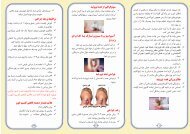ASFA_Clinical_Appli of TA.ppt [Compatibility Mode]
ASFA_Clinical_Appli of TA.ppt [Compatibility Mode]
ASFA_Clinical_Appli of TA.ppt [Compatibility Mode]
- No tags were found...
Create successful ePaper yourself
Turn your PDF publications into a flip-book with our unique Google optimized e-Paper software.
<strong>Clinical</strong> <strong>Appli</strong>cations <strong>of</strong>Therapeutic ApheresisPresentation:Pr<strong>of</strong>. A. Pourazar
<strong>TA</strong> TechnologiesMembrane• Prisma Gambro BCT• Asahi Plasma FlowCentrifugation• Cascade apheresis forselective plasmacomponent removal• Specialized devices
Apheresis in <strong>Clinical</strong> PracticeSickle Cell Dis.MalariaThrombocytosisRBCWBCPLTPlasmaLeukemiasCell TherapiesTTPGuillain Barre Syn.Myasthenia GravisGoodpasture’s Syn.Waldenstrom’s
Bloodletting and Plasmapheresis
“When it comes to bloodletting threequestions must be answered”• Who?• When?• How much?Which Replacement fluids
Efficiency <strong>of</strong> Plasmapheresis• What is beingremoved?• IgG - mainlyextravascular• IgM – mainlyintravascular70605040Percent3020100Efficiency <strong>of</strong> Plasmapheresis1 plasma vol1.5 plasma vol2 plasma vol
Exchange Fluids• 5% Albumin•Best choice•Dilute only with saline• Combination <strong>of</strong> saline and albumin• FFP• Cryopoor plasma
Diseases Treated with <strong>TA</strong>Guillain-Barre Syndrome 11%Myasthenia Gravis 12%CIDP 8%Cryoglobulinemia 30%Anti-GBM Disease 30%Pauci-immune RPGN 13%SLE nephropathy 10%Myeloma kidney 7%Recurrent FSG 5%Renal transplantation 5%
TTP – A Thrombotic Microangiopathy• Microvascular Occlusive Disorder• Platelet thrombi• Thrombocytopenia• Mechanical damage to erythrocytes• 70% <strong>of</strong> patients are women
TTP – hyaline thrombi inglomerolus
TTP – Mortality Rate90%80%70%60%50%40%30%20%10%0%Before Plasma ExchangeAfter Plasma Exchange
Pathophysiology <strong>of</strong> TTP• Presence <strong>of</strong> Unusually Large vonWillebrand Factor Multimers(ULvWFM)• Absence or low levels <strong>of</strong> ADAMTS13(vWF cleaving metalloprotease)• Presence <strong>of</strong> auto-antibodies antibodies toADAMTS13
Plasma Exchange in TTPFFP as exchange fluid• Removal <strong>of</strong> auto-antibodies antibodies to vWFmultimers cleaving enzyme• Infusion <strong>of</strong> vWF multimers cleavingenzyme
Pathophysiology <strong>of</strong> TTPNormalTTPCleaved von Willebrand FactormultimersPlatelet aggregatevWF-CleavingEnzymeAuto-antibody tovWF-CleavingEnzymeUncleaved unusuallylarge vWF multimersEndothelial CellEndothelial Cell
DiagnosisFrom Pentad to Triad• Thrombocytopenia• MAHA• CNS symptoms• Renal insufficiency• Fever• Thrombocytopenia• MAHA• LDH elevation
Conditions Associated with TTP• Primary (idiopathic)• Secondary• Systemic autoimmunedisorders• SLE• Rheumatoid arthritis• Scleroderma• Polyarteritis nodosa• Infectious diseases• HIV infection• Bacterial endocarditis• Drugs• Ticlopidine• Clopidrogel• Cyclosporine A• Tacrolimus• Quinine• Neoplastic diseases• Surgeries• Cardiovascular• Intestinal• PBSC transplantation• Pregnancy
Treatment <strong>of</strong> TTP• Daily plasma exchange• Exchange fluids•FFP•Cryopoor plasma•Detergent treated plasma• Treat until clinical symptoms improve andlaboratory values normalize• Avoid platelet transfusions
Treatment <strong>of</strong> persistent TTP• Plasma exchange• Corticosteroids• Vincristine• Rituximab• Splenectomy
Treatment <strong>of</strong> relapsing TTP• Plasma exchange• Treat beyond improvement• Consider adding medications• Splenectomy• Look for other disease association
TTP/HUS (Hemolytic UremicSyndrome)• HUS• MAHA• Renal failure• Classic HUS• Childhood, Escherichia coli 0157:H7 association• Adult HUS• Renal disease is more severe• Difficult to differentiate from TTP• Platelet – fibrin thrombi• Normal ADAMTS 13 (vWF cleaving enzyme) levels• No auto-antibody antibody to ADAMTS• Response to plasma exchange – equivocal results
Rapidly Progressive Glomerulonephritis(RPGN); Crescentic Glomerulonephritis• Subacute deterioration <strong>of</strong> renalfunction• Crescents in glomeruli• Various etiologies
Rapidly Progressive Glomerulonephritis(RPGN); Crescentic Glomerulonephritis• Goodpasture’s syndrome (Anti-GlomerularBasement Membrane Disease or Anti-GBMDisease)• Pauci immune RPGN (Wegener’sGranulomatosis or microscopicpolyarteritis with antineutrophilcytoplasmic antibodies (ANCA)• RPGN with granular immune complexdeposits sometimes associated withsystemic vasculitis
Goodpasture’s syndrome• Anti-GBM antibodies crossrectivewith alveolar basement membrane
Goodpasture’s Syndrome• <strong>Clinical</strong> presentation• RPGN• Pulmonary hemorrhage• Anti-GBM antibodies• Treatment• Immunosuppressive drugs• Cyclophosphamide• Corticosteroids• Azathioprine• Plasmapheresis (<strong>ASFA</strong> Category I)• Daily pheresis for 14 days with 5% albumin, 1-1 ½ plasmavolume• Finish procedure with 1 liter <strong>of</strong> FFP in cases with pulmonaryhemorrhage and /or renal biopsy
Pauci immune GN
Antineutrophil CytoplasmicAntibodies• ANCA by immun<strong>of</strong>luorescencemethods• c-ANCA = Wegener’sdisease (60% to 90%)• p-ANCA = microscopicpolyangiitis (MPA)(50% to 80%),UC (40% to 80%), Crohn’s(10% to 40%)H<strong>of</strong>fman GS. Arth Rheum. 1998;41(a):1521–1537.
Vasculitis
ANCA positive Pauci Immune• <strong>Clinical</strong> presentationRPGN•RPGN with or without pulmonary hemorrhage•Perinuclear (p-ANCA) ANCA)-systemic microvasculitis•Internuclear (c-ANCA) ANCA)-Wegener’sgranulomatosis• Treatment•Immunosuppressive drugs•Plasmapheresis (<strong>ASFA</strong> Category II) maybenefit patients with severe renal disease (Cr9) and dialysis dependent patients
Immune Complex RPGN (MPGN)
Immune Complex RPGN• <strong>Clinical</strong> presentation•RPGN•Membranoproliferative GN (MPGN)• Associations•Hepatitis C•Cryoglobulinemia• Treatment•Antiviral drugs•Corticosteroids•Plasmapheresis (<strong>ASFA</strong> Category II)
Acute Inflammatory DemyelinatingPolyradiculoneuropathy (AIDP)‘Guillain-Barre Syndrome (GBS)• Pathogenesis• Anti-myelin (gangliosides) antibodies GM1, GM1b, GD1a• <strong>Clinical</strong> presentation• Ascending paralysis• “albuminocytologic dissociation”• High CSF protein• No CSF pleocytosis• 10-23% require assisted ventilation• Nerve conduction studies show demyelination• dysautonomia• Treatment• Supportive care• IVIG 400mg/kg x 5 days• Plasmapheresis (<strong>ASFA</strong> Category I)• Start within 14 days <strong>of</strong> onset• 5-6 Q.O.D. procedures, 1-11 1/2 plasma volume exchange with 5% albumin
Anti-myelin Antibodies
GBS <strong>Clinical</strong> CourseGBS courseSymptom severityTime
Myasthenia GravisAcetylcholine (Ach)NerveAchRAnti-AchRAbMuscle
Myasthenia Gravis• <strong>Clinical</strong> picture•Variable degrees <strong>of</strong> weakness; improved byrest•Thymoma in 15% <strong>of</strong> patients• Treatment•Mestinon•Prednisone•Imuran or other immunomodulatory meds•Plasmapheresis (<strong>ASFA</strong> Category I)•IVIG400 mg/kg x 5 days•Thymectomy
Myasthenia Gravis• Plasmapheresis•Acute myasthenic crisis•Respiratory insufficiency•Failure to respond to medications•Side effects <strong>of</strong> medications (prednisone)•Before and after surgery (thymectomy)
Myasthenia GravisBefore plasmapheresisAfter Plasmapheresis
Hyperviscosity Syndrome• Causes• Wadenstrom’s macroglobulinemia 50%• Multiple myeloma 5%• <strong>Clinical</strong> presentation• Neurologic symptoms• Bleeding diathesis• Retinal hemorrhage and papilledema• Hypervolemia• Congestive heart failure• Treatment• Plasmapheresis (<strong>ASFA</strong> Category II)• Chemotherapy
Infectious agentAPCVIL-4 , IL-6AntibodiesT-cellB-cellPlasma cell
Systemic Lupus Erythematosus(SLE)• Systemic autoimmune disease with thepresence <strong>of</strong> autoantibodies and immunecomplexes (anti-DNA, anti-DS-DNA)DNA)• Multiple organ involvement including thekidneys• Controlled clinical trials failed to showbenefit from plasmapheresis in lupusnephropathy• Plasmapheresis (<strong>ASFA</strong> Category III)
SLE
Red Cell Exchange• Sickle Cell Disease• Malaria• Babesiosis
Sickle Cell Disease• <strong>Clinical</strong> picture• Chronic genetic anemia• Hgb S instead <strong>of</strong> Hgb A alters the erythrocytes and theirmembranes (sickle red cells)• Increased blood viscosity• Microvascular occlusion• Infarcts in brain, lungs, retina• Pain crisis• Priapism• Acute chest syndrome• Stroke• Treatment• Red cell transfusions• Hydroxyurea• Red cell exchange (<strong>ASFA</strong> Category I)• Aims to maintain Hgb S
Malaria• Cause• Plasmodium falciparum, vivax, ovale, malariae• Transmitted by female anopheline mosqito• Infected RBC adhere to endothelial cells <strong>of</strong> capillaries andpostcapillary venules via surface knobs• Microvascular obstruction <strong>of</strong> brain, kidneys,lungs• <strong>Clinical</strong> picture• Fever, malaise, headache• Neurologic impairment• Renal failure• ARDS• Traetment• Chloroquine, quinine, quinidine• Red cell exchange (<strong>ASFA</strong> Category III)• Plasmapheresis for removal <strong>of</strong> cytokines to prevent or treatlactic acidosis, hypoglycemia (NR)
White Cell DepletionLeukapheresis• Leukocytosis• Acute Myelogenous Leukemia (AML)• Chronic Myelogenous Leukemia (CML)• Acute Lymphocytic Leukemia (ALL)• Chronic Lymphocytic Leukemia (CLL)• <strong>Clinical</strong> picture• Hyperviscosity with microvascular occlusion• CNS symptoms• Hemorrhage• Pulmonary insufficiency• Treatment• Combination chemotherapy (tumor cell lysis leads to metabolicimbalance and ARDS)• Leukapheresis (<strong>ASFA</strong> Category I)• Ptreatment <strong>of</strong> leukocytosis• Prevention <strong>of</strong> tumor cell lysis syndrome
Plateletpheresis• Thrombocytosis (>1,000x 10 /L)•Essential•Polycytemia vera• <strong>Clinical</strong> picture•Microvascular occlusion• CNS symptoms• Hemorrhage• Pulmonary insufficiency• Treatment•Chemotherapy•Plateletpheresis (<strong>ASFA</strong> Category I)9
Rheumatoid Arthritis• Chronic inflammatory autoimmune disease•Arthritis•Rheumatoid nodules•Serum rheumatoid factor• Treatment•DMARD (Disease Modifying Anti RheumaticDrugs)•Anti-TNF alpha monoclonal antibodies•Apheresis• Plasmapheresis (<strong>ASFA</strong> Category IV)• Lymphoplasmapheresis (<strong>ASFA</strong> Category II)• Prosorba column (<strong>ASFA</strong> Category II)
Protein A binds IgG
Protocols for Reducing anti-HLAantibodies in positive CXM andAMR• IVIG alone• Plasmapheresis and IVIG• Plasmapheresis, IVIG and anti-CD20antibody (splenectomy)AmJTransplant 4(7): ):1033-1041, 2004
Protocols for Reducing anti-HLAantibodies in positive CXM and AMRIVIG 42 patientsPlasmapheresis and IVIG30% rejectionepisodes89% graftsurvival at 2years62 patients 94.2% graftsurvival at 3yearsAmJTransplant 4(7): ):1033-1041, 2004
References• Journal <strong>of</strong> <strong>Clinical</strong> Apheresis, Vol.15,No.1/2, 2000, Special Issue, <strong>Clinical</strong><strong>Appli</strong>cations <strong>of</strong> Therapeutic Apheresis• Journal <strong>of</strong> <strong>Clinical</strong> Apheresis 2000-2006• APHERESIS, Principles and Practice,2 nd Edition, Bruce McLeod Editor,AABB Press 2003


![ASFA_Clinical_Appli of TA.ppt [Compatibility Mode]](https://img.yumpu.com/40737067/1/500x640/asfa-clinical-appli-of-tappt-compatibility-mode.jpg)




